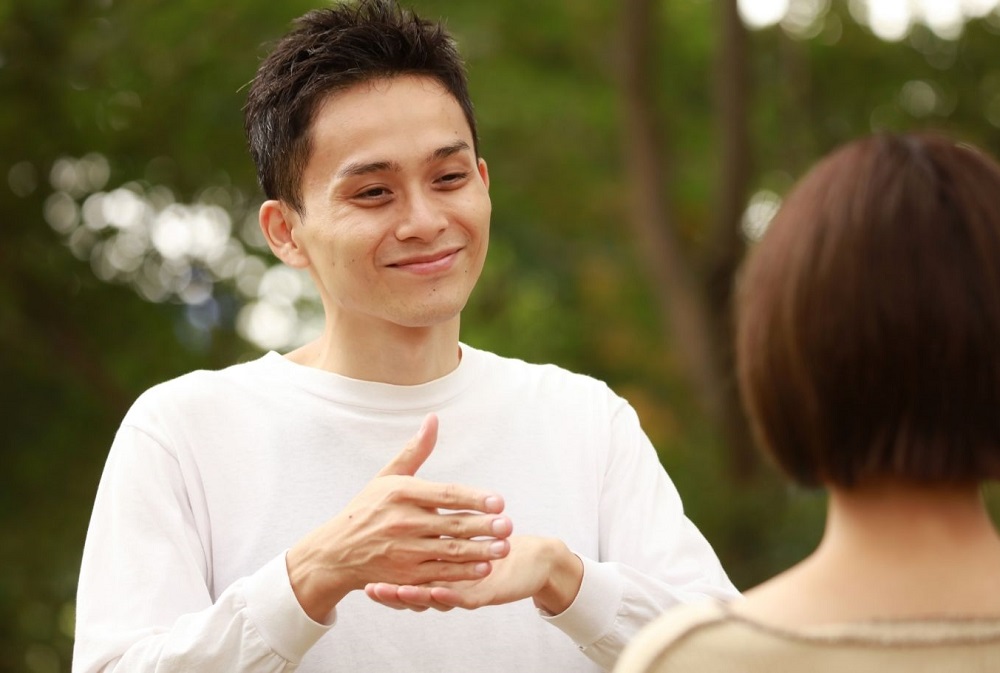Much like any oral language, sign language is a vast and nuanced form of communication, which can make it a little intimidating for new learners, but there’s really no need to be worried.
The best advice I can give you is to take it easy. Don’t force yourself to learn everything in one go. You’ll only end up overloading your brain, which isn’t good for memory recall at a later date.

Learning anything new is like juggling. You can think of each individual bit of information as a ball. The more information you take on board, the more balls you have to keep in the air, increasing the chances that you’ll drop (forget) them all.
It’s best to start with a small bit of information and lots and lots of repetition. As you would with any oral language, begin with essential basics of communication, such as hello, goodbye, and, of course, the topic of today’s article, thank you.
How to Sign Thank You
Another reason “thank you” is a fantastic place for you to start your singing journey is that it’s an incredibly easy sign to remember and perform. Let’s break it down into a few discrete sections, then we’ll attempt to perform it in one fluid motion.
Saying Thank You — Step 1. Preparing Your Palm
Thank you is a one-handed gesture in sign language, and one-handed gestures are always done with your dominant hand. So, if you’re right-handed, that’s the hand you’ll use. If you’re a lefty, that’s where your good manners will stem.
Don’t worry if you forget to use your dominant hand, as there are no strict rules that say you shouldn’t. You’re not accidentally going to be signing the wrong thing by accident, as all single-handed signs are the same with both the left and right hand.
The only reason it’s advised that you use your dominant hand is that it makes things easier for you. Dominant hands are stronger and more articulate, which can make picking up signs a more intuitive and flowing process.
Now that’s out the way, it’s time to get signing!
Take your dominant hand, turn your palm upwards and flatten it, stretching your fingers out whilst keeping them firmly together. Your thumb should protrude naturally from your hand.
Saying Thank You — Step 2. Starting the Sign
With your palm in position, it’s time to begin the gesture. Bring the tips of your fingers towards your chin or lips, keeping your hand as flat as possible. A smooth, almost rounded motion should be used to lift your palm. Try not to make any angular movements. It’s all about the flow!
There’s no need to touch your face. You can simply bring your fingers to within an inch or so of your chin or lips. It’s also important that at this stage you’re making direct eye contact with the person you’re thanking, otherwise, they may think you’re thanking someone else, which would be…awkward.
Saying Thank You — Step 3. Completing the Sign
Now you’re going to complete your thank you by moving your hand outwards and ever so slightly down towards the person you’re thanking. This final phrase is similar to blowing a kiss, although it’s generally a lot less elaborate and mushy.
To reinforce the sentiment of the sign, we can smile warmly at the recipient too, letting them know we truly mean that which we’re communicating — lovely!
Saying Thank You — Step 4. Bringing it All Together
Okay, so you’ve mastered the individual sections of thank you in sign language; now it’s time to thread them together into one magnificent, mannerly movement. Are you ready?
Palm up and fingers out — fingers to chin or lips — a gentle motion out and down
Voila, that’s it; you’ve done it! You just said thank you in sign language. Gathering the courage to sit down and start learning a language is the most difficult part, so from here on out, it’s plain sailing!
Is the Sign for Thank You the Same in All Sign Languages?
What you’ve just learned here today is the sign for thank you in American Sign Language (ASL). Just as saying thank you differs from oral language to oral language, so does it differ from sign language to sign language. However, again, much like oral languages, there are often cross-form/nation commonalities between words and phrases.
Take the sign for thank you in Libras, the sign language of urban Brazil, for example. The general hand shape and movements are the same, but the fingers reach towards the forehead rather than the lips. It even involves the same outward and down motion as thank you in ASL. It’s a wonderful tip-of-the-hat kind of gesture.
That said, many sign languages do indeed share the same sign for thank you as ASL, well…that’s not strictly true. I should say that ASL shares the same sign for thank you as other sign languages, as the blowing-a-kiss style gesture was borrowed by ASL from the French form, Langue Des Signes Francais (LSF).
In fact, Laurent Clerk, creator of LSF, was so dedicated to proliferating his visual language that over 60% of ASL signs can be traced back to one of his own original linguistic creations.
How to Say Thank You in Sign Language — Summing Up
That’s all there is to it, folks. Keep practicing, and don’t forget to watch video examples of the words you’re learning. You may think you have a sign down, but just as your inflection or accent can be off when learning a new oral language, your sign language gestures may seem a little stilted or awkward to fluent signers.
Now you can move onto a new word or phrase, begin growing your vocabulary, and eventually, move onto more advanced aspects of sign language such as syntax and body language. It won’t be long before you’ll be able to hold a full conversation with your signing!
